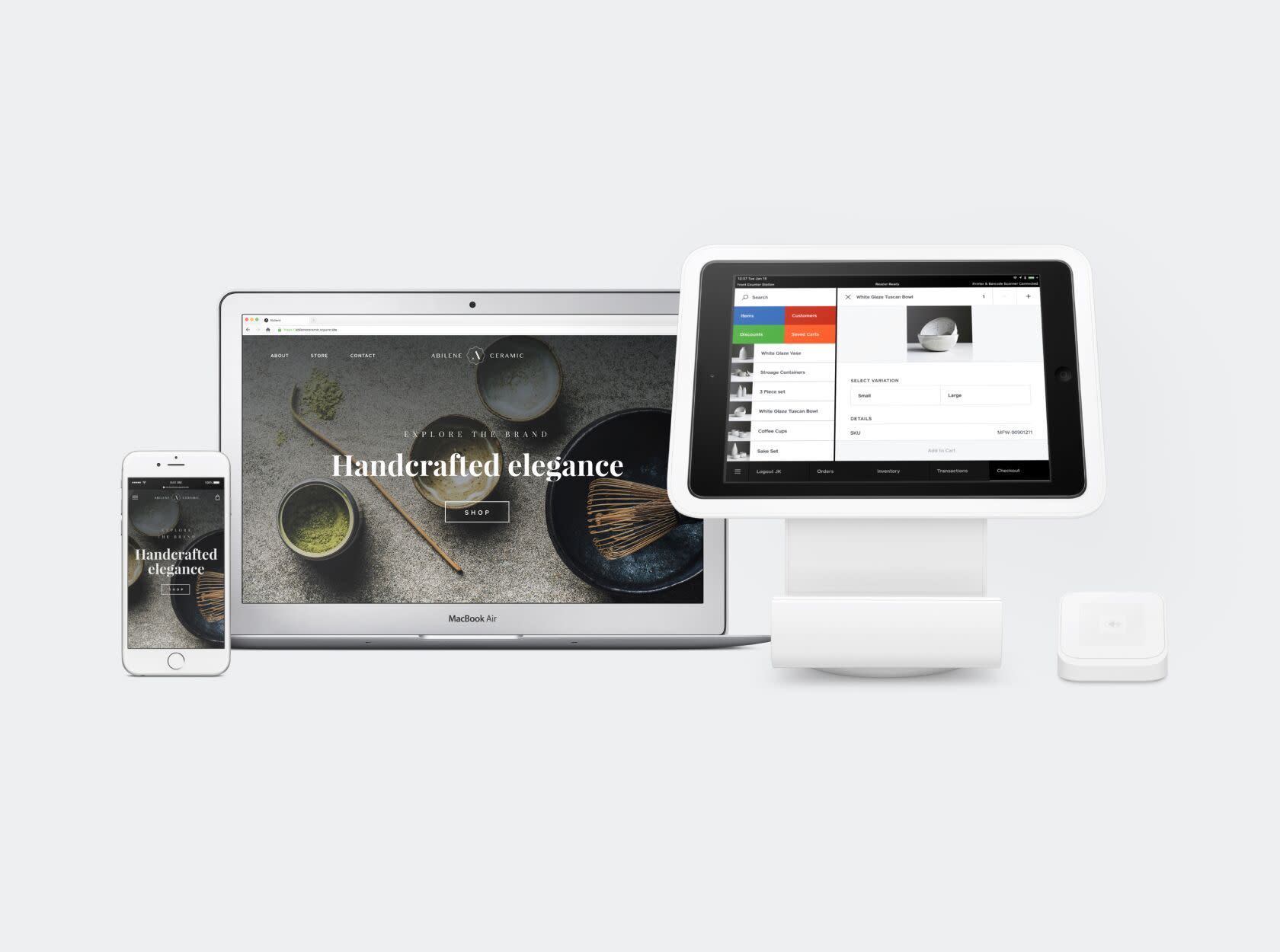In 2018, Weebly was acquired by Square, and since then, Weebly has adjusted its pricing model and features to better fit the needs of online stores (you can now host an online store on any Weebly site). Square also built their own Square Online Store using Weebly’s software as a foundation. Take payments online and in-person with Square. Get the Square extension for WooCommerce at no cost and instantly start accepting payments. With Square + WooCommerce, you can easily synchronize sales, inventory, and customer data, manage all your channels through one centralized platform and use one payment solution across all of them. You can easily take offline payments with any of these platforms – you just need to add an integration to Square, and buy a basic Square card reader ($49). This is ideal for those planning to sell at fairs or pop-up shops, as well as online. Square instantly syncs with your online inventory, so you don’t need to worry about over-promising. Introducing the first-party solution for managing your kitchen. View all your orders on one screen and stay on track with digital tickets, notifications and timers. Get detailed kitchen reports on your station performance and remove bottlenecks to increase efficiency. Square has acquired Weebly for an easy, affordable eCommerce option. Plus, Square’s list of integrations already includes some of the best shopping cart options — and the list keeps growing. Square is an omnichannel solution for merchants who want to sell anywhere without needing to build a complicated system of integrations or do a lot of.
- Introducing An Exclusive Weebly And Square Integration Calculator
- Introducing An Exclusive Weebly And Square Integration Center
Weebly is one of the most beginner-friendly platforms when it comes to web development. It enables newcomers to build stylish and usable sites, but it’s not the most feature-intensive solution around. For more power, you’ll need to turn to a platform such as WordPress.
While Weebly does offer a wide variety of features, it’s not a platform built with scalability in mind. Integrating it with WordPress solves this problem, while also offering enhancements in the form of ‘plugins’ – such as Sell Media, for example – and other functionality.
In this article, we’ll show you how to integrate Weebly with WordPress in four simple steps. However, before we get started you’re going to need two things to follow along – a Weebly account and a domain that’s linked to it.
Step #1: Find a WordPress-Friendly Host
First things first – you’ll need to find a web host for your WordPress installation. There are plenty of options available, but we recommend sticking to WordPress-friendly alternatives with good reviews and ratings. These types of hosts are optimized to provide you the best experience while using the platform, and they’re usually cost-effective to boot.
If you’re still wondering which host to plump for, or you just want a hassle-free path to a recommended host, we suggest Bluehost:
They offer a number of different pricing plans, along with good support for beginners. Purchasing a plan is simple, and while other hosts follow a similar setup route, the process may differ depending on your choice.
Step #2: Create a ‘Subdomain’ and Install WordPress


Even if you don’t know them by name, you’re likely already familiar with the concept of domains – think google.com or graphpaperpress.com. Subdomains are similar, except they can be used to set up parallel sites to your main one. For example, you could set up an e-commerce site on store.graphpaperpress.com and operate it separately from your main site. While your primary domain will direct visitors to your Weebly page, your subdomain will lead them to your WordPress store. Of course, you’ll already have the former, so let’s take a look at how to achieve the latter.
Log into your web host’s cPanel using the credentials you set up during step one, then look for an option that says Subdomains (or similar) and click on it:
On the following screen, choose a name for your subdomain and specify its parent, in case there’s more than a single domain associated with your account. Once you confirm your choice, your new subdomain will be ready to go!
Now we need to install WordPress. Return to your cPanel, and see if there are any WordPress-related options around. You’ll probably find it under the Softaculous App Installer section, although you’ll want to gravitate to anything similar to Install WordPress:
Hit the Install button on the next screen, then fill out all the required fields to begin the process. Most of them are self-explanatory (such as site name, username, etc.) but pay particular attention to the Choose Domain option near the top. From here, you’ll want to select your subdomain from the drop-down list:
When you’re done, hit the Install button at the end of the page – next up is customizing your new WordPress site.
Step #3: Customize Your WordPress Installation
WordPress provides you with a wide variety of customization options, but none more powerful than themes. These tools enable you to change the style and layout of your site with a few clicks, in a system very similar to Weebly’s.

There are thousands of free themes available, although you may want to consider a premium alternative. Whatever your choice, you’ll want to pick a theme that matches the style of your Weebly page, to make your future integration seamless. For example, take a look at Weebly’s Cento theme:
Now check out QUA, one of our premium photography themes:
They’re both similar enough to pass for each other with a few tweaks, and once you’ve installed it and made your changes, you’ll want to extend WordPress’ functionality through add-ons called plugins. Your choice of plugins will depend on the features you want, but some are essential for new sites.
Most of the time, you’ll want to get your plugins directly from WordPress’ directory, as they’ve been checked for quality and security. For example, you can find our Sell Media solution there:
This plugin will enable you to set up a photography store on your WordPress site, and it offers plenty of great extensions for enhancing its functionality too. These include the ability to enable subscriptions, offer time-expiring downloads, and much more.
With your customizations out of the way, it’s time to integrate your websites. For this, we’ll need to play with our site’s menus and navigation.
Step #4: Integrate Your Weebly and WordPress Sites
Integrating Weebly and WordPress is as simple as tweaking the navigation on both of your sites, so they link to each other seamlessly. If you set both of them up correctly – and make sure your sites match each other’s style – users might not even notice the difference between them.
To begin, log into Weebly and navigate to the Pages tab. Each new page you add here will automatically display on your main menu. Click on the plus sign to add a new page, and choose the External Page option:
From here, enter the name you want to appear on your menu, and paste in the URL to one of your WordPress pages. Now click Done and take a look at your menu:
Repeat the process for all of the pages you’d like to add, then head to your WordPress dashboard. You’ll find the Menu section under the Appearance tab:
Modifying your WordPress menu is a similar process to Weebly’s. To the left of the Menu Structure section, you’ll find a meta box with several tabs. You’ll want to use the Pages tab to add internal links to your menu, and the Custom Links option for Weebly URLs:
Clicking on Add to Menu will shift the new item to your Menu Structure section. Once there, you can drag and drop items around to re-arrange the order in which they appear. Once you’ve finished adding links, you’ve saved your changes, and you’ve double-checked that both menus match, the integration will be complete!
Conclusion
Depending on your needs, Weebly could be ideal for you, but the platform does lack scalability and some advanced functionality. Choosing to use WordPress in conjunction with it will open an entire world of possibilities. The best part is, you won’t even need to abandon your Weebly site to enjoy the benefits of using powerful plugins such as Sell Media.
If you’re intrigued by the idea of integrating Weebly with WordPress, here’s how to do it in four steps:
- Find a WordPress-friendly host.
- Create a subdomain and install WordPress on it.
- Customize your new WordPress website.
- Connect your Weebly and WordPress sites.
Do you have any questions about how to integrate Weebly and WordPress? Let us know in the comments section below!
Image credit: Pixabay.
From themes to editors, the two most popular website builders have important differences.
Wix and Squarespace are the two biggest website builders— and it’s not even close. Together they power 55% of websites that are built with a website builder.
But while they’re both popular they also have stark differences. It’s almost like Mac vs PC— Squarespace is curated and design-y while Wix is occasionally chaotic but allows for a lot of freedom to customize.
I recommend Squarespace over Wix but it’s important to understand the differences— and that’s what this article will explain.
Note: My work is supported by affiliate commissions. Read more »
At A Glance
Two Most Popular Website Builders
Wix and Squarespace combined are 55% of the website builder market— significantly more than any other company.
Mac vs PC
Their differences are almost like Mac vs PC: Squarespace is curated and design-y while Wix is occasionally chaotic but allows for a lot of freedom to customize.
Different Page Editors
Wix is an unstructured editor where you drag elements anywhere on a page. Squarespace is a structured editor where elements snap into columns and rows.
Both Have Excellent Features
There are core features that every website builder just needs to have: photo galleries, maps, forms, audio players— that kind of thing. Both Wix and Squarespace have these covered. (Wix may have a slight edge in the amount of features.)
Templates
Wix has more templates than Squarespace but Squarespace has better templates. This isn't necessarily a knock on Wix's templates as Squarespace has the best templates of any website builder.
The Editor
Introducing An Exclusive Weebly And Square Integration Calculator
The biggest difference between Wix and Squarespace is the page editor.
With Wix you can move any element anywhere on your page— even moving elements by one pixel if you want. It’s an unstructured editor:
Being able to drag an element anywhere on a page feels freeing BUT it can also lead to frustrating problems.
For example, watch what happens when I move an image from the top of the page to the bottom:

I had to make the same change twice— once for the the desktop version and once for the mobile version! Wix’s unstructured editor didn’t know to automatically do this. That’s frustrating!
This is not a problem you would have with Squarespace— because Squarespace has a structured editor.
In Squarespace, you can’t move an element anywhere on a page. Instead Squarespace only allows you to drag elements (called Content Blocks) into rows and columns. There’s an inherent and sensible structure that you stay within.
Introducing An Exclusive Weebly And Square Integration Center
Overall I recommend Squarespace’s structured page editor over Wix’s unstructured page editor. Wix’s unstructured editor may give you more flexibility but it introduces a cascade of knock-on problems— such as having to make the same edit twice.
